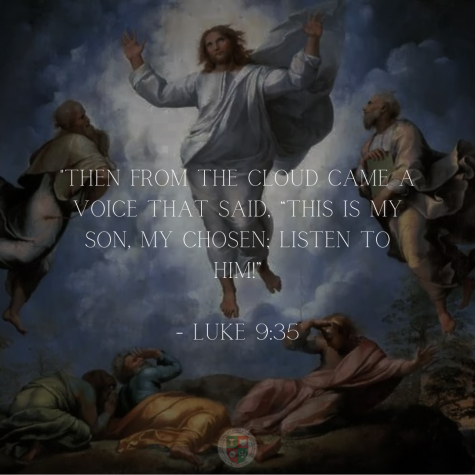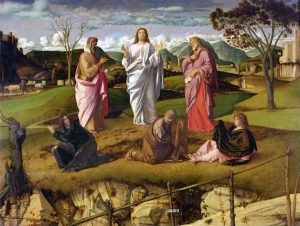“This is my Son, my Chosen; listen to him!” – The History and Significance of The Church’s Feast of The Transfiguration
August 3, 2023

On August 6th, both Roman and Eastern rite Catholics are celebrating the Church’s feast of the Transfiguration today, and this day is the traditional date for both calendars.
The feast commemorates a significant event in Jesus’ life, where he revealed his divinity to three of his closest disciples. All three Synoptic Gospels narrate the Transfiguration story (Matthew 17:1-8; Mark 9:2-9; Luke 9:28-36). Interestingly, they all place the event shortly after Peter’s confession that Jesus is the Messiah and Jesus’ first prediction of his passion and death. This event is crucial in Jesus’ life and ministry because it confirms his divinity and fulfills the Old Testament prophecies.

The Transfiguration, 1480 (oil on panel) by Bellini, Giovanni (c.1430-1516);
After six days Jesus took Peter, James, and John and led them up a high mountain apart by themselves. And he was transfigured before them, and his clothes became dazzling white, such as no fuller on earth could bleach them. Then Elijah appeared to them along with Moses, and they were conversing with Jesus. Then Peter said to Jesus in reply, “Rabbi, it is good that we are here! Let us make three tents: one for you, one for Moses, and one for Elijah.” He hardly knew what to say, they were so terrified. Then a cloud came, casting a shadow over them; then from the cloud came a voice, “This is my beloved Son. Listen to him.” Suddenly, looking around, they no longer saw anyone but Jesus alone with them. – (Mark 9:2-8)
According to Scripture scholars, it is challenging to fully comprehend the disciples’ experience, as the Gospels draw heavily from Old Testament descriptions of encounters with God at Mount Sinai and prophetic visions of the Son of Man. Nevertheless, Peter, James, and John had a profound experience of Jesus’ divinity, which left them awe-struck with fear. They used familiar religious language to describe the indescribable encounter since such a description defies description.
Within Christian doctrines, the transfiguration assumes a momentous role, and the mountain setting symbolizes the juncture where humanity encounters the divine: a place where the finite meets the infinite, and Jesus serves as the intermediary, bridging the realms of heaven and earth.
During the Transfiguration, Jesus was accompanied by the Old Testament figures of Moses and Elijah, demonstrating how he fulfills the Law and the Prophets. In the ancient scriptures of the Old Testament, the Levitical law was bestowed upon God’s people as a provisional arrangement, highlighting their need for a Savior. Subsequently, the prophets prophesied about a future Messiah who would reconcile the separation between God and humanity caused by sin. Jesus emerged as the sole individual capable of fulfilling the Law, embodying the flawless and sinless sacrifice.
In this passage, God validates Jesus as His Son, confirming His divinity and instructing the disciples to heed His words. Peter, James, and John catch a glimpse of Jesus’ authentic glory as God the Son, an eternal ruler unyielding to the powers of hell. God the Father reveals Himself similarly to how He appeared to the Israelites in the Old Testament, veiled in a cloud due to the overwhelming magnitude of His glory. This same resplendent glory radiates from Jesus, causing His clothes to gleam brightly. This event underscores both the enigmatic and imperative nature of the Incarnation—God had to become a human for us to find reconciliation with Him, as our finite and sinful state prevents us from beholding His complete majesty.
Additionally, Jesus points his disciples to his future resurrection, providing hope for triumph over sin and death. The Transfiguration represents a promise of what is to come.
As they were coming down from the mountain, he charged them not to relate what they had seen to anyone, except when the Son of Man had risen from the dead. So they kept the matter to themselves, questioning what rising from the dead meant. – Mark 9:9-10
The Feast of the Transfiguration has a rich history, with tradition associating Mount Tabor as the site of the revelation. The feast was celebrated in the Eastern Church from the fourth century and later in the Western Church from the eighth century.
As crusaders achieved victory over the Turks at Belgrade on July 22, 1456, the news of this triumph reached Rome on August 6, prompting Pope Callistus III to include the feast in the Roman calendar the subsequent year.
Pope Benedict XVI, in his address before the Angelus in 2006, highlighted how the Transfiguration displays Christ as the “full manifestation of God’s light.” This light, shining forth from Christ both during the Transfiguration and after his resurrection, triumphs over the darkness of evil. The Pope emphasized that this feast is an opportunity for believers to turn to Christ as “the light of the world” and experience a conversion from darkness to light.
“In our time too,” Pope Benedict said, “we urgently need to emerge from the darkness of evil, to experience the joy of the children of light!”
For Eastern Catholics, the Feast of the Transfiguration holds particular significance as one of the 12 “great feasts” of Eastern Catholicism. Eastern Christianity views Christ’s transfiguration as the Christian form of “enlightenment”, facilitated by the ascetic disciplines of prayer, fasting, and charity.
In 2002, Pope John Paul II incorporated the Transfiguration into the Luminous Mysteries of the rosary.
Categories
Discerning, a Vocations BlogGeneral News
Stirrings
Uncategorized
New Basilian Associates Begin Their Journey
From left to right: Diego Alejandro Martínez López, José de Jesús Rodríguez Pérez, CSB, José Yonni Villa de Jesús, José Juan Téllez Hernández We joyfully celebrated the Incorporation of three […]
Read MoreSt. Basil’s Parish Celebrates 169th Founding Anniversary
This past weekend we celebrated 169 years since St. Basil’s Parish first opened its doors in Toronto. Since then, countless generations have gathered here to pray, celebrate, and grow in […]
Read MoreSt. Thomas Begins Year with Holy Spirit Mass
As the University of St. Thomas begins a new academic year, the campus community gathered for the Mass of the Holy Spirit — a cherished tradition that invites God’s guidance, […]
Read MoreBasilians Begin New Ministry in Houma-Thibodaux
This week, our Superior General visited the Diocese of Houma-Thibodaux, where Basilians Fr. Osman de la Hoz and Fr. Jose Alberto Juarez are serving the growing Hispanic community with dedication […]
Read MoreFr. George Smith Blesses New Student Center
Fr. George Smith, CSB blessed the new center in the Lavery Library, marking a significant milestone in St. John Fisher University’s commitment to academic excellence and student support. The center […]
Read More